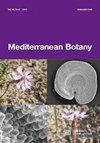蝎尾草(禾本科):多年生燕麦草还是一年生雀麦草?
IF 0.7
4区 生物学
Q3 PLANT SCIENCES
引用次数: 1
摘要
蝎尾蛾的前选型。(Poaceae)已被取代,因为它与原序有严重冲突。原序的另一个元素被指定为有效选型。新选型与Bromus intermedius Guss共特异。一种地中海的凤梨属植物。叶片。新组合全景Helictochloa panormitana (Lojac.)Romero Zarco是为最初描述为Avena australis Parl的物种提出的。不,不合法。这种植物目前被称为辛辛那提Helictochloa cincinnati auct。凤梨的选型研究。阿维纳·普伦塔·洛亚克。和凤尾雀。也是指定的。本文章由计算机程序翻译,如有差异,请以英文原文为准。
Bromus cincinnatus (Poaceae): perennial oat-grass or annual brome-grass?
A former lectotype for Bromus cincinnatus Ten. (Poaceae) has been superseded, as it is in serious conflict with the protologue. Another element of the protologue has been designated as the effective lectotype. The new lectotype is identified as coespecific with Bromus intermedius Guss., a Mediterranean species of Bromus L. subg. Bromus. The new combination Helictochloa panormitana (Lojac.) Romero Zarco is proposed for the species originally described as Avena australis Parl., nom. illeg., which is currently known as Helictochloa cincinnata auct. The lectotypes of Avena panormitana Lojac., Avena opulenta Lojac., and Bromus intermedius Guss. are also designated.
求助全文
通过发布文献求助,成功后即可免费获取论文全文。
去求助
来源期刊

Mediterranean Botany
Agricultural and Biological Sciences-Plant Science
CiteScore
2.40
自引率
10.00%
发文量
30
审稿时长
12 weeks
期刊介绍:
Mediterranean Botany (ISSNe 2603-9109), formerly Lazaroa, is a biannual journal that publishes original research studies in the field of Botany including plant systematics, vegetation ecology, biogeography, evolutionary biology, ecophysiology, community ecology, ethnobotany and conservation biology on Mediterranean biomes but also in interacting areas.
Mediterranean Botany is an OPEN ACCESS Journal, free of charges for any published article.
 求助内容:
求助内容: 应助结果提醒方式:
应助结果提醒方式:


